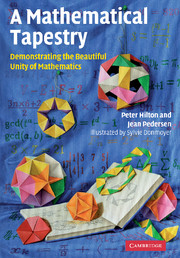Book contents
- Frontmatter
- Contents
- Preface
- Acknowledgments
- 1 Flexagons – A beginning thread
- 2 Another thread – 1-period paper-folding
- 3 More paper-folding threads – 2-period paper-folding
- 4 A number-theory thread – Folding numbers, a number trick, and some tidbits
- 5 The polyhedron thread – Building some polyhedra and defining a regular polyhedron
- 6 Constructing dipyramids and rotating rings from straight strips of triangles
- 7 Continuing the paper-folding and number-theory threads
- 8 A geometry and algebra thread – Constructing, and using, Jennifer's puzzle
- 9 A polyhedral geometry thread – Constructing braided Platonic solids and other woven polyhedra
- 10 Combinatorial and symmetry threads
- 11 Some golden threads – Constructing more dodecahedra
- 12 More combinatorial threads – Collapsoids
- 13 Group theory – The faces of the trihexaflexagon
- 14 Combinatorial and group-theoretical threads – Extended face planes of the Platonic solids
- 15 A historical thread – Involving the Euler characteristic, Descartes' total angular defect, and Pólya's dream
- 16 Tying some loose ends together – Symmetry, group theory, homologues, and the Pólya enumeration theorem
- 17 Returning to the number-theory thread – Generalized quasi-order and coach theorems
- References
- Index
2 - Another thread – 1-period paper-folding
Published online by Cambridge University Press: 10 November 2010
- Frontmatter
- Contents
- Preface
- Acknowledgments
- 1 Flexagons – A beginning thread
- 2 Another thread – 1-period paper-folding
- 3 More paper-folding threads – 2-period paper-folding
- 4 A number-theory thread – Folding numbers, a number trick, and some tidbits
- 5 The polyhedron thread – Building some polyhedra and defining a regular polyhedron
- 6 Constructing dipyramids and rotating rings from straight strips of triangles
- 7 Continuing the paper-folding and number-theory threads
- 8 A geometry and algebra thread – Constructing, and using, Jennifer's puzzle
- 9 A polyhedral geometry thread – Constructing braided Platonic solids and other woven polyhedra
- 10 Combinatorial and symmetry threads
- 11 Some golden threads – Constructing more dodecahedra
- 12 More combinatorial threads – Collapsoids
- 13 Group theory – The faces of the trihexaflexagon
- 14 Combinatorial and group-theoretical threads – Extended face planes of the Platonic solids
- 15 A historical thread – Involving the Euler characteristic, Descartes' total angular defect, and Pólya's dream
- 16 Tying some loose ends together – Symmetry, group theory, homologues, and the Pólya enumeration theorem
- 17 Returning to the number-theory thread – Generalized quasi-order and coach theorems
- References
- Index
Summary
Should you always follow instructions?
All self-respecting human beings, and therefore all our readers, must answer this question with a resounding NO! In the next paragraph we describe two aspects of our paper-folding, and building, instructions where we do advise rather rigid adherence to our specifications. However, we are very far from recommending that you fold all your regular polygons and construct all your polyhedra exactly as described. What we have done is to give you algorithms for the relevant constructions. Machines follow algorithms with relentless fervor, while human beings look for special ways of doing particular, convenient things. Always feel free to use your ingenuity to avoid an algorithm that is not working for you, or seems to you to be unduly complex.
A word to the wise
We've done a lot of field-testing of the “hands-on” material in this book. Our instructions seem to be, on the whole, quite comprehensible to most readers. However, there are two basic types of error that people seem prone to make in carrying out our instructions.
Material error
In doing mathematics, it is absurd to specify the quality of paper on which the mathematics should be done. However, when we describe to you how to make mathematical models, we must insist that the choice of material is not arbitrary. Instructions for making models that are easily constructed using gummed mailing tape are unlikely to be effective if a strip of paper taken from an exercise book is used instead.
- Type
- Chapter
- Information
- A Mathematical TapestryDemonstrating the Beautiful Unity of Mathematics, pp. 17 - 38Publisher: Cambridge University PressPrint publication year: 2010



